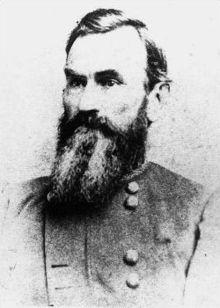Benjamin Grubb Humphreys | |
|---|---|
 General and Governor of Mississippi | |
| 26th Governor of Mississippi | |
| In office October 16, 1865 – June 15, 1868 | |
| Preceded by | William L. Sharkey |
| Succeeded by | Adelbert Ames |
| Member of the Mississippi Senate | |
| In office 1839–1844 | |
| Personal details | |
| Born | August 26, 1808 Claiborne County, Mississippi Territory |
| Died | December 20, 1882 (aged 74) Jackson, Mississippi |
| Political party | Democratic |
| Signature | |
| Military service | |
| Allegiance | |
| Branch/service | |
| Years of service | 1861–65 |
| Rank | |
| Commands | 21st Mississippi Infantry Regiment Humphreys' Brigade |
| Battles/wars | American Civil War
|
Benjamin Grubb Humphreys (August 26, 1808 – December 20, 1882) was an American politician from Mississippi. He was a general in the Confederate States Army during the American Civil War and served as Governor of Mississippi from 1865 to 1868, during Reconstruction.
Early life
Humphreys was born in Claiborne County in the Territory of Mississippi, on the Bayou Pierre. He was educated in New Jersey and enrolled at West Point in the same class as Robert E. Lee and Joseph E. Johnston. However, he was expelled in 1826 when he participated in a "Christmas frolic" that ended up turning into the Eggnog Riot.
Upon his return to Mississippi, he was elected to the state senate representing his native county, serving from 1839 to 1844. In 1846, he moved to Sunflower County, Mississippi, and founded Itta Bena. He developed a cotton plantation there.
Civil War
Humphreys raised a company and was commissioned a Captain in the Confederate States Army in 1861. Being part of the 21st Mississippi Infantry Regiment he was elected to the rank of Colonel the same year. Brigaded with other regiments under command of Brig. Gen. William Barksdale he fought in the Eastern Theater. At the Battle of Gettysburg in 1863 Humphreys's regiment was part of the force that attacked Federal positions at the Peach Orchard, driving the defenders back toward Cemetery Ridge. Humphreys took command of the brigade after the death of Barksdale. He was subsequently promoted to Brigadier General,[1] and remained in command until he was wounded in the battle of Berryville, Virginia, on September 3, 1864. Humphreys returned home to Mississippi to convalesce, but was unable to return to active duty before the war ended.
Political career
After the surrender of the Confederate Army, Southern politicians and Army officers were not automatically pardoned and were forbidden to hold public office. At the time of his candidacy, Benjamin Humphreys was unpardoned, and President Andrew Johnson did not want him elected. Unwilling to withdraw his candidacy, on October 2, 1865, Humphreys was elected as a Democrat, but was not immediately recognized as the Governor of Mississippi. Without presidential approval, on October 16, 1865, Humphreys had himself inaugurated and sworn in as the 26th Governor of Mississippi. By October 26, 1865, Mississippi provisional Governor, William L. Sharkey, received from President Andrew Johnson a pardon authorizing political office under the Reconstruction plan. He won re-election in 1868 and continued with a second term, but with the beginning of Congressional control of Reconstruction he was physically removed by occupying U.S. armed forces on June 15 of that year.[2]
As a Democratic Governor of the State of Mississippi, he encouraged Jim Crow laws. In his own words:
The Negro is free, whether we like it or not; we must realize that fact now and forever. To be free, however, does not make him a citizen, or entitle him to political or social equality with the white race.
After his retirement from politics, Humphreys entered a career in insurance in Jackson, Mississippi. He continued there until his retirement in 1877, when he moved to his plantation in Leflore County, Mississippi, where he died in 1882. He is buried in Wintergreen Cemetery, Port Gibson, Mississippi.[3]
Humphreys County, Mississippi, is named after him. His son, also named Benjamin G. Humphreys, entered into a political career of his own. He became a Congressman and was on the Harbors and Rivers Committee, where he was instrumental in the successful amendment that created and added levees to the charter of the commission.
See also
- List of American Civil War generals (Confederate)
Notes
References
- McKitrick, Eric L. "Andrew Johnson and Reconstruction". New York, NY: Oxford University Press, 1988. ISBN 0-19-505707-4
- Eicher, John H., and David J. Eicher, Civil War High Commands. Stanford: Stanford University Press, 2001. ISBN 978-0-8047-3641-1.
- Pfanz, Harry W. Gettysburg – The Second Day. Chapel Hill: University of North Carolina Press, 1987. ISBN 0-8078-1749-X.
- Warner, Ezra J. Generals in Gray: Lives of the Confederate Commanders. Baton Rouge: Louisiana State University Press, 1959. ISBN 978-0-8071-0823-9.
- Mississippi History
- History Central
| Party political offices | ||
|---|---|---|
| Preceded by John J. Pettus | Democratic nominee for Governor of Mississippi 1865 | Vacant Title next held by John Marshall Stone |
| Political offices | ||
| Preceded by William L. Sharkey | Governor of Mississippi 1865–1868 | Succeeded by Adelbert Ames |